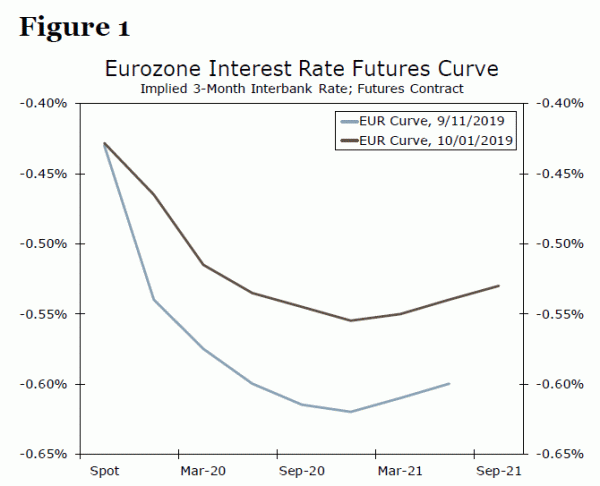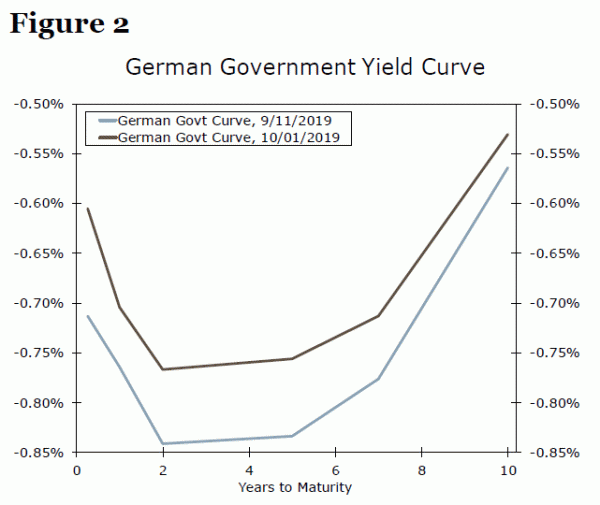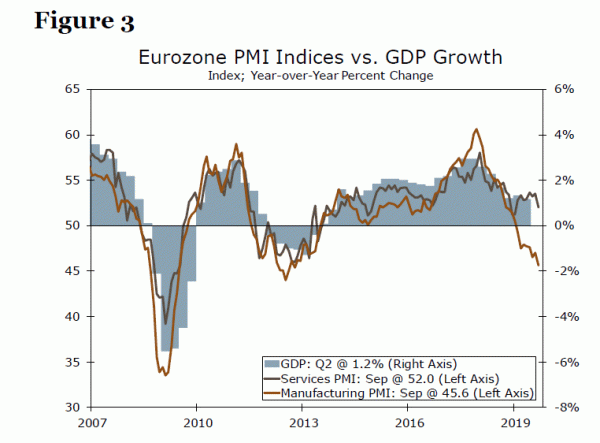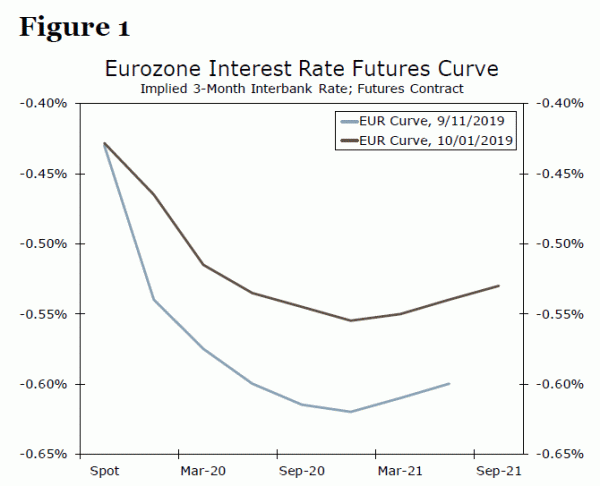Executive Summary
- The ECB announced a substantial package of easing measures at its September meeting, but the market response mostly fell flat, and indeed if anything financial conditions appear to have tightened since the announcement. Most market interest rates are higher, while the euro and equity prices are mostly flat.
- This is hardly good news for a Eurozone economy already flirting with recession. The latest data from the bloc have been more concerning, and while we do not think a full-scale recession is imminent, we nevertheless worry about a more protracted period of underwhelming growth.
- In that context, we expect the ECB to cut rates again in December. Turning to the currency outlook, the risks of more near-term euro downside have increased.
ECB Easing: More is Less?
In response to concerns about slow economic growth and persistently below target inflation, the European Central Bank (ECB) announced a package of monetary easing measures at the meeting of the Governing Council on September 12. In particular, the ECB:
- Cut its deposit rate 10 bps to -0.50%.
- Resumed its asset purchases at a pace of €20 billion per month, starting in November.
- Announced a “tiering” system, which exempts a larger portion of commercial banks’ reserves held at the ECB from negative interest rates.
With the benefit of two weeks now to have monitored the market reaction to the ECB’s policy announcement, we believe the central bank may well be disappointed with the extent of the market reaction to date. Despite the ECB’s best efforts to provide more monetary policy accommodation there is little evidence of any easing in overall financial market conditions. The trade-weighted value of the euro is only slightly lower since the announcement, while Eurozone equity markets are more or less flat over the same period. In fact, specifically for fixed income markets, we would argue that if anything conditions are more restrictive than prior to the ECB’s monetary policy action.
We believe a couple of factors may have contributed to the underwhelming reaction from fixed income markets. First, the tiering system which sees a larger portion of reserves exempt from negative interest rates will likely see some liquidity removed from interbank money markets, or potentially influence trading activity within interbank money markets, both of which may have contributed to an increase in money market rates as well as bond yields. Second, in the wake of the ECB’s decision to ease policy in September, there were reports that a significant cohort of ECB policymakers pushed back against the central bank’s monetary policy actions, perhaps lessening market expectations for future ECB easing moves.
These effects are clearly evident in European money markets as well as some key Eurozone government bond markets. Figure 1 captures how the three-month Euribor futures curve has shifted since the ECB policy announcement. The blue line shows futures curve on September 11, just before the ECB announcement, while the brown line shows the Euribor futures curve today. That is, implied three-month interbank interest rates have actually shifted materially higher since the ECB’s policy decision in early September.

A similar response is also apparent among some of the key Eurozone government bond markets. For example, yields on German government bonds are higher now than they were prior to the ECB announcement out to maturities of around ten years (Figure 2), as is also the case for French government bonds. To be sure, medium to longer-dated Spanish and Italian government yields are lower now than prior to the ECB’s announcement. On net however, we believe that overall conditions in Eurozone fixed income markets are more restrictive now than prior to the ECB decision.

Eurozone Economy: Still Down, Still Not Out
The (arguably) underwhelming reaction so far from Eurozone financial markets, and in particular fixed income markets, will do little to support the Eurozone economy. Moreover, on the economic front we would highlight that the latest news has not gotten any better. In particular, the Eurozone manufacturing and service sector PMIs suggest the economy stumbled in September. The Eurozone manufacturing PMI fell to 45.6, the lowest level since 2012, while even the usually more resilient services PMI dropped to 52.0. As a result, the Eurozone September composite PMI fell to 50.4 and a drop in the composite PMI below 51.0 has often been a precursor to, or a signal of, a Eurozone economy in recession.

At this time we are not forecasting a recession for the Eurozone economy, although we acknowledge that the risks of a recession are growing. In particular, the consumer (and by extension the service sector) has been a source of stability and resilience for Eurozone growth, with employment growth, wage growth and to a lesser extent household consumer spending all contributing to an ongoing Eurozone expansion, albeit at a moderate pace. Accordingly, we would watch particularly closely for a softening in these consumer-related data as signaling the most significant risk of the Eurozone economy moving from “slow growth” to “outright recession.” Even if the Eurozone economy avoids recession, as we expect, we do see potential for noticeably slower Eurozone growth in the second half of this year compared to the first, and would not be surprised if the economy came to a standstill in Q3 (that is, zero growth on a sequential or quarter/quarter basis).
It Ain’t Over Til It’s Over
Against this economic backdrop, and despite the reported reluctance and resistance by some ECB policymakers to further monetary easing, we do expect the central bank to ease monetary policy further by the end of this year. We think that easing is more likely to come at the December 12 policy announcement than at the October 24 announcement, in part because important policy initiatives—the ECB’s renewed bond purchases and the interest rate tiering system—do not operationally begin until November. We anticipate the ECB will want to see the financial market effects of these policy actions in practice over several weeks before making any decision on whether further policy adjustments are needed. The ECB leadership transition at the end of October, with outgoing ECB President Draghi to be replaced by President Lagarde, is another reason why further monetary policy action may be more likely in December than October.
In terms of further policy adjustments, we expect the ECB to lower its deposit rate a further 10 bps in December, bringing that rate to -0.60%. We also believe there is a reasonable chance at that meeting the ECB will recalibrate its interest rate tiering system to make fewer excess reserves exempt from negative interest rates. The ECB’s goal here would be to balance somewhat conflicting objectives of keeping interbank interest rates low, while not excessively harming Eurozone commercial bank profitability. Overall, we do expect the anticipation and implementation of ECB December monetary policy easing will lead to a reduction in key Eurozone market interest rates and bond yields either heading lower into and/or shortly after that December meeting.
The combination of slow Eurozone economic growth and further ECB easing clearly has the potential to weigh further on the euro. With the negative economic and monetary policy forces described earlier still in place, the risks for the euro remain tilted to the downside, and a further fall in the EUR/USD exchange rate remains a distinct possibility in the near term. Over the longer term, we still see euro upside, although that view is increasingly becoming predicated on a further slowdown in the U.S. economy rather than a pickup in the Eurozone economy. If relative U.S.-Eurozone growth does not in fact converge further, and especially if the Eurozone economy slips and enters outright recession, that would jeopardize our view for longer-term euro gains.


 Signal2forex.com - Best Forex robots and signals
Signal2forex.com - Best Forex robots and signals




